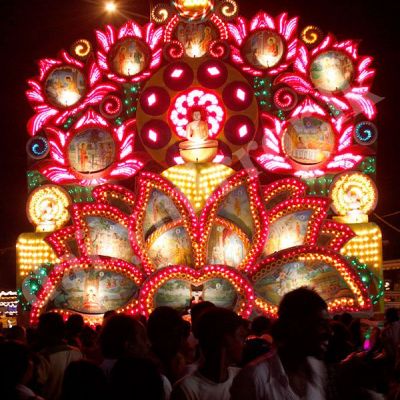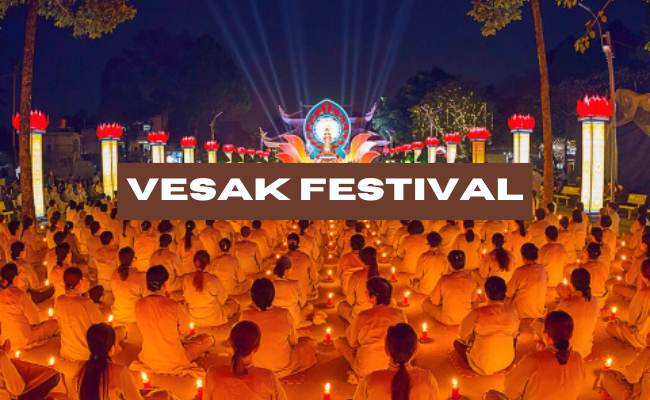Vesak (Pali: Vesākha; Sanskrit: Vaiśākha), also known as Buddha Jayanti, Buddha Purnima, Buddha Day, is a holiday traditionally observed by Buddhists in South Asia and Southeast Asia, as well as Tibet and Mongolia. It is the most important Buddhist festival. The festival commemorates the birth, enlightenment (Nibbāna), and passing (Parinirvāna) of Gautama Buddha in Theravada, Tibetan Buddhism and Navayana.
The name Vesak is derived from the Pali term vesākha or Sanskrit vaiśākha for the lunar month of Vaisakha, which is considered the month of Buddha’s birth. In Mahayana Buddhist traditions, the holiday is known by its Sanskrit name (Vaiśākha) and derived variants of it.
In the East Asian tradition, a celebration of Buddha’s Birthday typically occurs around the traditional timing of Vesak, while the Buddha’s awakening and passing away are celebrated as separate holidays that occur at other times in the calendar as Bodhi Day and Nibbāna Day. In the South Asian tradition, where Vesak is celebrated on the full moon day of the Vaisakha month, the Vesak day marks the birth, enlightenment, and the ultimate passing away of the Buddha.

History Behind Vesak Festival
Buddhists do not believe in one god who created the universe and everything in it. In truth, the majority of Buddhists believe in the teachings of Siddhartha Gautama, generally known as Buddha. Siddhartha Gautam is thought to have been a prince born into a wealthy household in what is now called Nepal around the fifth century BC. It is thought that Siddhartha Gautama realized that money and luxury did not ensure happiness. So he traveled as a homeless holy man to learn more about the world and witness the sorrow that exists.
It is thought that after six years of learning and meditating while traveling, he became spiritually conscious and achieved his goal of finding meaning in life. This is known as enlightenment. At this point, he became the Buddha, and he spent the remainder of his life teaching his disciples about his experiences. Buddha is a title, not a name, that denotes the enlightened or awakened one.
Celebration
The month of May usually has one full moon, but as there are 29.5 days between full moons, occasionally there are two. Suppose there are two full moons during May. In that case, some countries (including Sri Lanka, Cambodia and Malaysia) celebrate Vesak on the first full moon. In contrast, others (Thailand, and Singapore) celebrate the holiday on the full moon of 4th lunar month. The difference also manifests in the observance of other Buddhist holidays, which are traditionally observed at the local full moon.[19]
On Vesak, devout Buddhists and followers alike assemble in their various temples before dawn for the ceremonial and honorable hoisting of the Buddhist flag and the singing of hymns in praise of the holy triple gem: The Buddha, The Dharma (his teachings), and The Sangha (his disciples). Devotees may bring simple offerings of flowers, candles and joss sticks to lay at the feet of their teacher. These symbolic offerings are to remind followers that just as the beautiful flowers would wither away after a short while, and the candles and joss sticks would soon burn out, so too is life subject to decay and destruction. Devotees are urged to make a special effort to refrain from killing of any kind. They are encouraged to partake only of vegetarian food for the day. In some countries, notably Sri Lanka, two days are set aside for the celebration of Vesak, and all liquor shops and slaughterhouses are closed by government decree during the two days.
Also birds, insects, and animals are released by the thousands in what is known as life release to give freedom to those who are in captivity, imprisoned, or tortured against their will. (The practice, however, is banned in some countries such as Singapore, as the released animals are unable to survive long-term or may adversely impact the local ecosystem if they do.)[20]
Some devout Buddhists will wear simple white clothing and spend the whole day in temples with renewed determination to observe the eight precepts.
Devout Buddhists undertake to lead a noble life according to the teaching by making daily affirmations to observe the Five Precepts. However, on special days, notably new moon and full moon days, they observe the eight precepts to train themselves to practice morality, simplicity, and humility.
Some temples also display a small statue of the Buddha in front of the altar in a small basin decorated with flowers, and filled with water or sweet tea for devotees to pour over the statue. This is symbolic of the cleansing of a practitioner’s bad karma, and to reenact the events following the Buddha’s birth, when devas and spirits made heavenly offerings to him.
Devotees are expected to listen to talks given by monks. On this day, monks will recite verses uttered by the Buddha twenty-five centuries ago to invoke peace and happiness for the government and the people. Buddhists are reminded to live in harmony with people of other faiths and to respect the beliefs of other people as the Buddha taught.
Dates of celebration
The exact date of Vesak is based on Asian lunisolar calendars and is primarily celebrated in Vaisakha, a month of both the Buddhist and Hindu calendars, hence the name Vesak. In Nepal, which is considered the birth country of Buddha, it is celebrated on the full moon day of the Vaisakha month of the Hindu calendar and is traditionally called Buddha Purnima, Purnima meaning the full moon day in Sanskrit. In Theravada countries following the Buddhist calendar, it falls on Uposatha Day, the full moon typically in the 5th or 6th lunar month.
Nowadays, in Sri Lanka, Nepal, India, Bangladesh, and Malaysia, Vesak/Buddha Purnima is celebrated on the day of the first full moon in May in the Gregorian calendar.
For countries using the lunisolar calendar, the date for Vesak or Buddha’s Birthday varies from year to year in the Gregorian calendar, but usually falls in April or May; in leap years it may be celebrated in June. In Bhutan, it is celebrated on the 15th day of the fourth month of the Bhutanese lunar calendar. In Thailand, Laos, Singapore, and Indonesia, Vesak is celebrated on the fourteenth or fifteenth day of the fourth month in the Chinese lunar calendar. In China, Korea, Vietnam, and the Philippines, Buddha’s Birthday is celebrated on the eighth day of the fourth month in the Chinese lunar calendar. In Japan, Buddha’s Birthday is observed on the same date but in the Gregorian calendar, i.e. 8 April.
In Myanmar, Buddha’s Birthday is celebrated as the Full Moon of Kasun and is a public holiday. It is celebrated by watering the Bodhi tree and chanting. In large pagodas, music and dance is also performed as part of the celebrations
